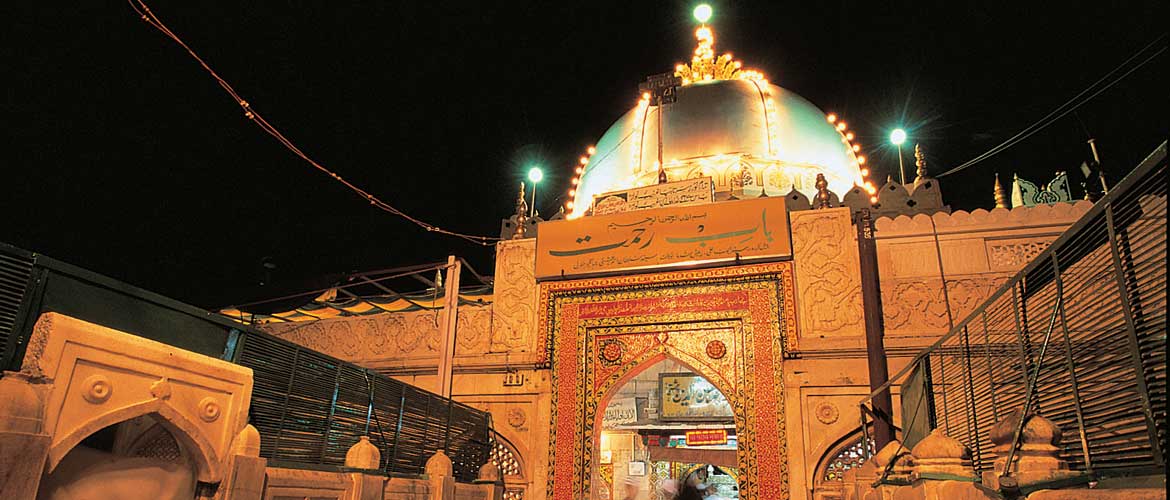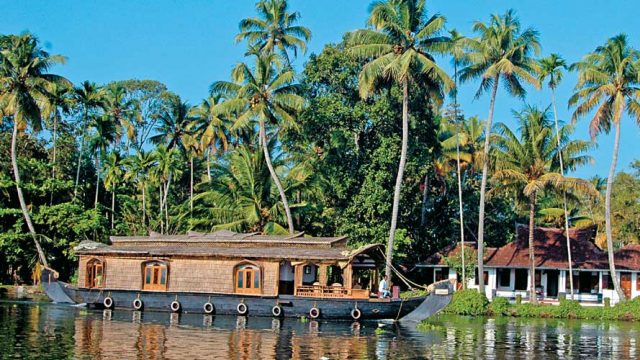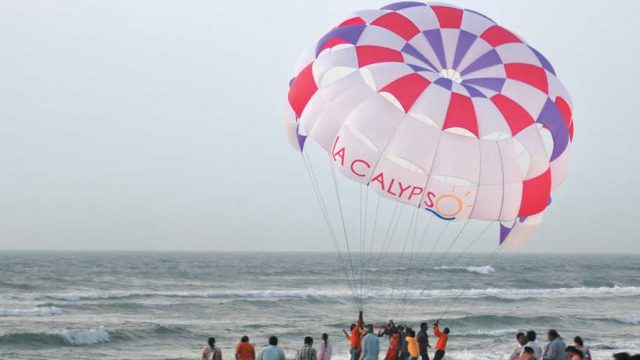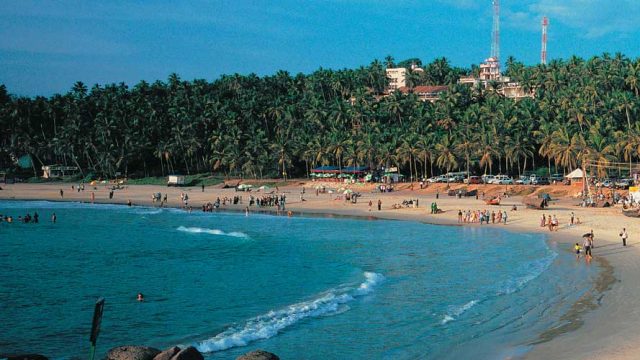Faith and history define Ajmer. The town’s closest association is with the Dargah Sharif, the
Once a stronghold of the Chauhan Rajputs, Ajmer (then called Ajayameru) was lost by the legendary Prithviraj Chauhan when he was defeated by Muhammad Ghori in 1193 CE. Akbar made it a part of the Mughal Empire in the 16th century. It was at Ajmer that the first English ambassador Sir Thomas Roe presented his credentials to Jahangir in 1617 CE.
Like the Mughals, the British used Ajmer as a centre for exercising control over the region, but they also built educational institutions – including the Mayo College, set up for boys from India’s princely families.

THINGS TO SEE AND DO
Hazrat Khwaja Moinuddin Chishti, popularly known as Garib Nawaz (helper of the poor), is a giant figure on the Sufi map of the sub-continent. Among the first Sufi saints to come to India, he led an illustrious line of Chishti saints in India, including Nizamuddin Auliya and Salim Chishti.
The Khwaja was revered for his austere life that spanned a century. Devotees believe that he intercedes on their behalf to the almighty to answer their prayers. The most famous of his devotees, Akbar, walked from Agra to Ajmer over 16 days in 1570 CE praying for a heir to his throne.
The Urs marks the death anniversary of the Khwaja and is observed during the first six days of ‘Rajab’ (the 7th month of the Islamic calendar), around 22–23 May. During the Urs, the crowds and the emotional fervour in Ajmer is overwhelming, qawwalis are sung all night, while brocade chadars arrive from the powerful of the land.
The Dargah Complex
The dargah (an Islamic shrine built on the grave of a saint) is a complex full of many structures. The entrance gates, which loom 70ft over the congested bazaar, were built by the Nizam of Hyderabad in 1915 CE. To the right, steps lead to the red sandstone Akbari Masjid (1571 CE). Ahead lies the grand 15th-century Buland Darwaza. Next come two degs (cauldrons), gifted by Akbar and Jahangir, to cook food sponsored by devotees for mass distribution. On the right spreads the Mehfil Khana, a hall opened only for the Urs, and on the left, the Langar Khana, a hall where free food is served.

Ahead lies the compound in which many buildings stand around the tomb. The first is the Sandali Masjid, built by Aurangzeb. The path to the right leads to the tomb of the Khwaja’s daughter, Bibi Hafiza Jamal; the tomb of Nizam Sikka, a water-carrier who had saved Humayun’s life; and a silver Jannati Darwaza, rarely opened. Overlooking these is Shah Jahan’s Jami Masjid (1638 CE), a building made of white marble.
The vast courtyards on either side of the tomb are often occupied by qawwali singers. The facet on the left is called the Begumi Dalaan, built in 1643 by Shah Jahan’s daughter Jahanara. Its walls were gilded in 1888 CE and the ceiling etched with gold.
Inner Sanctum Timings 4.30am–3.00pm & 4.00–9.30pm Tel 0145-2429332, 2623948
Tip The sanctum area is closed for about an hour (3.00–4.00pm) for cleaning but devotees can visit the outer areas anytime during the day and night. You have to park your vehicle (₹150–200) outside Delhi Gate. It is a 5-minute-walk to the dargah
Other Sights
Walk down a congested alley to the left of the dargah entrance to see the exquisitely carved 12th-century Adhai-Din-ka-Jhonpra, built by Sultan Qutubuddin Aibak and completed by Iltutmish. There are some charming picnic spots in Ajmer. These include Ana Sagar (Timings: Sunrise–sunset), an artificial lake; Ajaipal, where the founder of Ajmer retired after his reign; and Foy Sagar, another artificial lake outside the town. You should also visit the ornate Golden Hall of the Jain Nasiyan Temple. The Taragarh Fort (open all day) is 5km from town, offers nice views and can be easily visited by car or auto.

Painted Beauties
The tiny kingdom of Kishangarh, founded by Kishan Singh, a prince of the pre-Independence Jodhpur state, is renowned for its marble quarries. The marble for the Taj Mahal too was sourced from Makrana nearby. Less well-known is the fact that Kishangarh was once the centre of a fine artistic tradition. From its ateliers were created some of the finest miniatures the country has seen. Of these, the most famous paintings are of Bani Thani, the royal mistress, whom the painters used as a model for Radha – the icon of the Kishangarh School.
Within Kishangarh town, there are many studios where painters continue to toil over miniature paintings, and these make the finest souvenirs.
The erstwhile Maharaja, Brajraj Singh, has converted the Phool Mahal Palace (Tel: 01463-247405, 247505; Tariff: ₹4,700–5,500) within Kishangarh Fort into a boutique heritage hotel.
Roopangarh Fort, 26km from Kishangarh, was built in 1648. The palace within the fort has been restored and converted into a heritage hotel (Tel: 01497-220217, 225444; Tariff: ₹5,000–7,000) with 22 rooms and one suite.
Kishangarh is 27km from Ajmer (towards Delhi) on NH8.
WHERE TO STAY
Hotel Mansingh Palace (Tel: 0145-2425702/ 855; Tariff: ₹5,400–9,000), near the lake, is Ajmer’s finest hotel.
Hotel Embassy (Tel: 2425519, 2623859; Tariff: ₹1,995–3,995) is a good choice. RTDC’s Hotel Khadim (Tel: 2627490/ 536; Tariff: ₹1,500–3,000) has rooms that suit all budgets.
It’s worth opting for Badnor House (Tel: 2627579; Tariff: ₹3,000) as well, which offers a bed-and-breakfast stay in a lovely private house.
WHERE TO EAT
In the lanes around the dargah, you’ll find roadside eateries specialising in biryani. Among the better-known restaurants is the multicuisine Honeydew on Station Road (Continental and Mughlai). Rasoi in Swami Complex, on Suchna Kendra Road, serves a variety of delicious food and is quite popular. Ambrosia, Hotel Ambassador’s rooftop restaurant, on Lohagal Road serves delectable food and has good views of the Aravallis. Enjoy a meal facing the lake at Sheesh Mahal, the restaurant at Mansingh Palace. Silverleaf, the restaurant at Hotel Embassy, serves only vegetarian Indian, Continental and Chinese cuisine.
AROUND AJMER
Pushkar (11km)
Kartik Poornima – the full moon of November – brings excitement to Pushkar, for this is when the world-famous camel fair takes place on the sand dunes surrounding the town. Thousands of traders come here to trade in camels and other animals, as well as meet up and negotiate marital ties, visit the holy temples and take a dip in Pushkar’s lake. The festivities continue for almost a fortnight.
At the heart of Pushkar is the Brahma Temple, with Brahma’s vahan, a turtle, cast in silver at its entrance. At the foot of the temples is the sarovar, surrounded by bathing ghats.
Stay at Pushkar Palace (Tel: 0145-2773001-03; Tariff: ₹7,000–15,000), a heritage property and the only luxury hotel on the lake. Or try RTDC’s Hotel Sarovar (Tel: 2772040; Tariff: ₹600–1,900). Only vegetarian food is available in Pushkar. For decent Indian food go to RTDC’s Hotel Sarovar and Pushkar Palace’s Prince Restaurant. For an exhaustive menu, go to Sunset Café. The Halwai-ki-Gali offers kachoris and samosas with malpuas.
FAST FACTS
When to go Best in winter. Pushkar and Kishangarh can be charming during the rains. Summer is best avoided
Tourist Office
Rajasthan Tourism, Tourist Reception Centre, Hotel Khadim (RTDC), Ajmer, Tel: 0145-2627426
STD code 0145
GettingThere
Air Nearest airport: Jaipur (145km/ 3hrs). Taxi ₹1,800–2,500 depending on the vehicle you opt for
Rail Ajmer Junction is well connected to Delhi, Jaipur, Mumbai and Ahmedabad. Local taxis cost ₹180–250 per hour (for an AC car)
Road Ajmer is located on NH 8, which connects Delhi to Mumbai via Jaipur and Ahmedabad. Plenty of autos and taxis around town, but be prepared to negotiate fares especially during the Urs Bus Ajmer is served daily by several buses from Jaipur’s Sindhi Camp Bus Terminal
India
Unmissable India
Rajasthan





